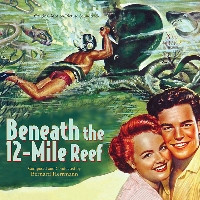- Composed by Bernard Herrmann
- Kritzerland / 2015 / 55m
With the surge in popularity of television in the early 1950s, movie studios had to do something to keep people going to the cinema and so they fell over themselves to introduce ever wider pictures on the big screen. Twentieth Century Fox’s version was CinemaScope and debuted in late 1953 with The Robe; it was still a novelty a couple of months later when Beneath the 12-Mile Reef came along to a highly muted critical reception and audiences went and went and went again. Loosely based on Romeo and Juliet but transported to Florida and two warring seafaring families, the film may have been a rather routine melodrama but parts of it looked unlike anything people had seen before; and with his music, the great Bernard Herrmann transcended any limitations of the film and provided a score that ranks as one of his towering achievements.
Along with the spectacular picture, audiences were treated to something that was very much still a rarity at the time – stereo sound. Herrmann seemed to take great inspiration from this, with his score – particularly for the underwater sequences – designed to envelop the viewer and take him or her on a great odyssey. The composer even marked his desired microphone placement on his manuscript. Of particular note is the unique composition of the orchestra, which features no fewer than nine harps, each with its own part, spread across the stereo range.
The striking “Prelude” captures the attention immediately, swirling brass playing over those harps before the strings take up the dramatic main theme. Then in “The Undersea” the composer sets the tone that is to dominate – the harps absolutely captivating in the shafts of light they generate over the murk of the deep, deep winds; ever undulating, ever in motion, it’s an astonishingly effective colour palette from a composer with a brilliant mind, so perfectly evocative you really don’t need to see the picture to know exactly what the audience was seeing.
In the next cue, “The Boat”, the score’s romantic side gets its first airing, with a brief theme of longing and love. Then “The Homecoming” features a jaunty nautical theme, the feeling overwhelmingly happy. “The Conch Boat” is a very brief cue but features some typical brassy Herrmann action music. (I’m always amazed at how much the composer was able to put into those very short cues he frequently wrote.) “Flirtation” is the score’s prettiest piece, full of the joys of spring and young love. There’s a certain Hitchcockian feel to “The Marker”, ominous but beautiful. “Elegy” is a sweeping, unsurprisingly sad piece with the strings giving it their all and is one of the score’s standout moments without doubt. The action/suspense of “The Fire” is brilliant: orchestral lines dancing around each other before a cacophonous explosion. “Escape” goes from thrilling action into striking variations on the main theme.
Having said all that – there’s no doubting the real star of the show and that’s the dazzling music for the underwater sequences. “The Undersea Forest” is tremendous, an eerie calm gradually being consumed by darkness but not before going through moments of extraordinary beauty. It’s Bernard Herrmann at his very best, painting with dazzling colours and weaving an intoxicating spell. “The Lagoon” offers a kind of undersea fantasy, a romantic waltz with lots of warm textures playing against the familiar backdrop – and I just love the way the composer hints at lurking dangers as the piece nears its conclusion, blending them so well into the development of the piece. “The Sea Garden” is another rich tapestry of genteel sounds from the harps before the spectacular “The Octopus” features some of the most aggressive music from that instrument that I’ve ever heard, ominous and jagged and combining flawlessly with the dark colours from the rest of the orchestra.
For many years the only way you could hear this on disc was to listen to the Charles Gerhardt suite; Film Score Monthly first put the whole score out back in 2001. It sounded as good as it could at the time but was not without its problems; technology allowed Mike Matessino to make it sound a lot better for Varese’s expensive Herrmann at Fox box and this 2015 release from Kritzerland allows that (so far) definitive master to be heard by itself. It’s an all-time-great film score – Herrmann at his best was film music at its best – and deserves a place in anyone’s collection.
Rating: *****
facebook.com/moviewave | twitter.com/MovieWaveDotNet | amazon.com













Great review of a stunning score!